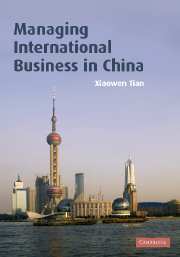Book contents
- Frontmatter
- Contents
- List of figures
- List of tables
- List of boxes
- Preface
- 1 Introduction
- 2 Look before you leap
- 3 Manage guanxi strategically
- 4 Select an entry mode
- 5 Form an alliance
- 6 Negotiating with Chinese partners
- 7 Production operations management
- 8 Marketing management
- 9 Human resource management
- 10 The protection of intellectual property rights
- 11 Corporate finance considerations
- References
- Index
- References
7 - Production operations management
Published online by Cambridge University Press: 05 June 2012
- Frontmatter
- Contents
- List of figures
- List of tables
- List of boxes
- Preface
- 1 Introduction
- 2 Look before you leap
- 3 Manage guanxi strategically
- 4 Select an entry mode
- 5 Form an alliance
- 6 Negotiating with Chinese partners
- 7 Production operations management
- 8 Marketing management
- 9 Human resource management
- 10 The protection of intellectual property rights
- 11 Corporate finance considerations
- References
- Index
- References
Summary
The need to successfully operate facilities in any location is clearly an important task for both subsidiary and headquarters management. As China continues to liberalize its economic and political regime, foreign firms have to work within the constraints and requirements of that environment while leveraging the advantages they possess in terms of size and resources, and their experience in the Chinese setting (Rajib N. Sanyal and Turgut Guvenli (2001, p. 45)).
Production operations are the ‘processes that produce goods and services’ or the ‘processes that transform inputs into products and services’ (Krajewski and Ritzman, 2002, p. 1). As such, they play a crucial role in the value creation of a firm, and need to be managed carefully. Production operations management in an international setting differs from production operations management at home in many ways. In managing production operations in China, transnational corporations need to take into account the Chinese business environment and the challenges that that environment poses for them. In this chapter we discuss some key issues that TNCs need to address in managing production operations in China, including the siting of their manufacturing facilities, the choice of location, localization of sourcing and localization of research and development.
The siting of manufacturing facilities
In establishing manufacturing facilities in China, transnational corporations need to think about the way in which the manufacturing facilities are arranged – that is, the siting of the facilities. China is a huge country with a vast territory.
- Type
- Chapter
- Information
- Managing International Business in China , pp. 152 - 176Publisher: Cambridge University PressPrint publication year: 2007
References
- 1
- Cited by



